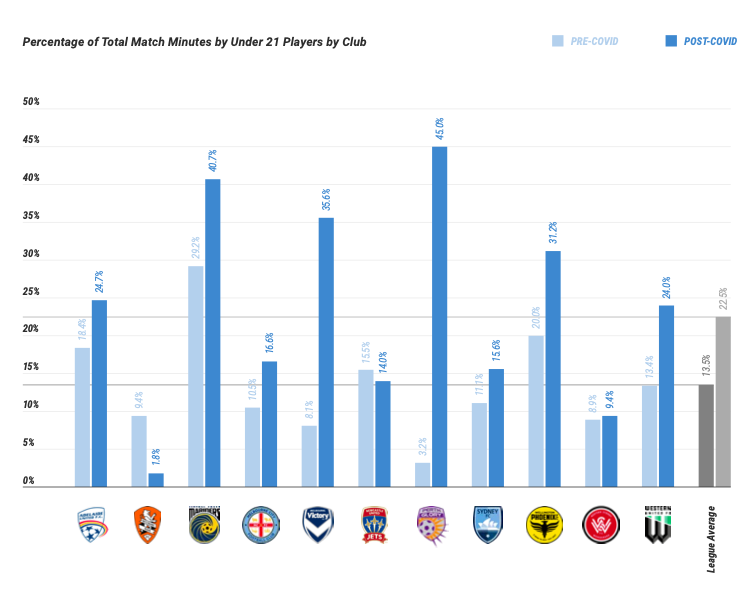Australian players under the age of 21 enjoyed a 66% increase in match minutes following the A-League’s restart, the Professional Footballers Australia (PFA) A-League Report reveals.
The 2019/20 edition of the PFA’s annual review of the A-League delivers a unique perspective of the recently concluded campaign, due to the significant impact of COVID-19.
Following the competition’s resumption after a four-month hiatus, A-League clubs turned to youth to help them complete the rescheduled season in July and August, resulting in an increase from 13.5% (pre-COVID-19) to 22.5% of match minutes afforded to Australians under the age of 21.

Across the A-League the individual opportunities for Australian youth rose sharply, with Adelaide United’s Taras Gomulka and Melbourne Victory’s Aaron Anderson accumulating 92.7% and 80% of match time respectively in July and August; the highest among their age group. Match minutes accumulated by under-21 players also increased significantly at clubs, with Perth Glory’s jump the highest; from 3.2% to 45%.

While the impact of COVID-19 provided the circumstances and impetus for clubs to field under-21 players, the Report highlights a wider trend, with the number of match minutes available to under-21 players in the A-League more than doubling in the past three seasons.
Click here to download the full PFA A-League 2019/2020 Report
The 40-page Report utilises Opta statistics and the PFA’s annual A-League player survey to build an assessment of Australia’s domestic men’s league covering four key areas: Employment Framework, League Assessment, Technical Report and Injury Report.
Other findings of the report include:
- In a five-year comparison against 80 other football nations, Australia ranks mid-table in respect to match minutes afforded to under-21 players; with the A-League offering far more opportunity than traditional AFC rivals Japan, South Korea, Saudi Arabia and Iran;
- Players aged between 26-30 have experienced a 30% increase in match minutes across the past three seasons, while the A-League’s average match minutes for players aged 31 and over has declined by almost 30% during the same period;
- 53% of players in the A-League are aged 24 and under;
- 78% of current A-League players were developed in the metropolitan centres of Sydney, Melbourne and Adelaide;
- Australian players reach their maximum earning potential in the A-League at age 31.
PFA Co-Chief Executive Beau Busch welcomed the release of the Report, which provides a critical framework for evaluating and charting the A-League’s progress and the experience of Australia’s professional footballers.
“From crisis comes opportunity; despite the unprecedented disruption to last season, there were a number of positive trends that emerged that provide a significant opportunity for the A-League to build upon as our game begins its longer-term recovery from next season,” Busch said.
“Encouragingly, players under the age of 21 have experienced a significant increase in match minutes across the past two A-League seasons, while the technical report highlights the outstanding quality on the pitch, despite the significant challenges faced by the players.
“Amidst uncertainty, the A-League remains a critical part of the Australian football ecosystem. We must capitalise on the A-League’s strengths and address its weaknesses as we rebuild and reboot the competition, and this Report provides an evidence-based foundation for the game to activate and focus recovery in the right areas.”

In the same manner as the W-League 2019/20 Report, the A-League 2019/20 Report incorporates direct feedback from players via the PFA’s Annual Player Survey on a range of topics impacting their A-League careers.
PFA Executive Member and Newcastle Jets captain Nigel Boogaard said the players’ collective feedback was critical to ensuring the experience of Australia’s professional footballers is evaluated and enhanced.
“Understanding and measuring the players’ experience is critical to how we shape our competition and how we better support our players during their careers to ensure our game’s international competitiveness and that it meets its basic duty of care to the players,” Boogaard said.
“As we seek to get the game back on its feet, it is vital that we deeply understand the challenges it is facing and then commit to a comprehensive recovery plan to rebuild it as genuine partners.”







